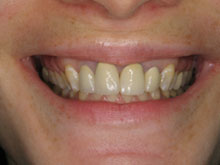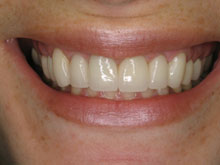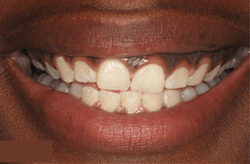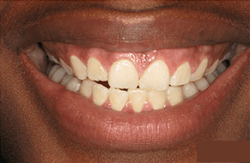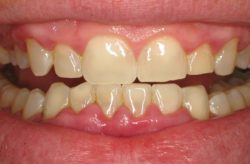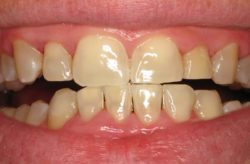LANAP Laser Treatment for Periodontal Disease
Laser Assisted New Attachment Procedure (LANAP)
Laser-assisted new attachment procedure (LANAP) is a minimally invasive surgical treatment used to address periodontitis, a severe form of gum disease that can lead to tooth loss, and worse; bacteria can enter the bloodstream and reach the heart or lungs. People with gum disease are 2-3x more likely to have a heart attack, or stroke. The innovative procedure LANAP employs the use of a specialized dental laser to remove the harmful bacteria and diseased tissue from the gum line, allowing for the regeneration of healthy gum tissue and the reattachment of gum tissue to the tooth’s surface.
LANAP is considered a revolutionary technique in the field of periodontal treatment, as it offers numerous advantages over traditional surgical methods. Using a laser eliminates the need for incisions and sutures, which means less pain and discomfort for patients and a faster and smoother recovery period. In comparison to traditional treatment methods, LANAP is a more targeted treatment approach that only removes diseased tissue, leaving healthy tissue intact and reducing the risk of damage to the teeth and gums.
The LANAP procedure is performed by a specially trained periodontist and requires a thorough evaluation of the patient’s dental history and current condition. During the procedure, the laser is used to remove the damaged tissue, stimulate the regeneration of healthy tissue, and promote the reattachment of teeth to the gums. The result is a healthier and more stable foundation for the teeth, leading to improved oral health and a better quality of life for the patient.
Comparing LANAP to Traditional Gum Disease Treatments
LANAP offers numerous advantages compared to existing gum disease treatments, such as traditional gum surgery and scaling and root planing (SRP). Traditional gum surgery involves making incisions in the gum line and removing the diseased tissue manually, which can be painful and lead to a more extended recovery period. In contrast, LANAP uses a laser to target and remove only the diseased tissue, leaving healthy tissue intact and promoting faster healing with minimal discomfort for the patient.
Similarly, scaling and root planing is an effective procedure which involves deep cleaning of the teeth and gums to remove the plaque and tartar buildup and reduce inflammation. However, this method can be ineffective in treating severe cases of gum disease and may require multiple sessions to achieve the desired results. On the other hand, LANAP has been shown to be highly effective in treating even advanced stages of gum disease in just one session, reducing the need for multiple appointments and increasing patient satisfaction.
Another benefit of LANAP over traditional gum disease treatments is that it is less invasive and more precise. The use of a laser allows for greater accuracy in targeting diseased tissue, minimizing the risk of damage to surrounding healthy tissue and reducing the likelihood of complications or side effects.
While traditional gum disease treatments may still have their place in certain cases, LANAP offers a more advanced and patient-friendly alternative that can provide superior results with fewer drawbacks.
The Advantages of Laser-Assisted New Attachment Procedure over Traditional Gum Surgery
LANAP offers several advantages over traditional gum surgery. Some advantages of Laser-Assisted New Attachment Procedure include:
- Minimally Invasive. There is no cutting, and fewer sutures are required with the LANAP procedure.
- Advanced Laser Technology. A precise laser tool is used to target and remove only the diseased tissue, which results in less pain, swelling, and bleeding than traditional gum surgery. LANAP can also be used to treat any stage of gum disease, whereas traditional gum surgery is often reserved for more severe cases.
- Shorter Recovery Period. Compared to traditional gum surgery, LANAP requires less recovery time.
- Shorter Treatment Process. LANAP can be performed in just one or two sessions, while traditional gum surgery may require multiple appointments.
- High Success Rate. The Laser-Assisted New Attachment Procedure has a high success rate and can help to save teeth that may otherwise need to be extracted due to severe gum disease.
For more information about LANAP and its benefits in treating any case of gum disease, call (877) 440-3564 to consult with one of our specialists and have all of your questions answered.
The Importance of Early Diagnosis and Treatment for Gum Disease
Gum disease, also known as periodontal disease, is a common oral health condition that affects the gums, jaw bone, and other tissues surrounding the teeth. It is caused by a buildup of plaque, a sticky film of bacteria that forms on the tooth’s surface and, in more advanced cases, below the gum line. If left untreated, gum disease can lead to serious health problems, including tooth loss, bone loss, and even systemic diseases such as heart disease, stroke, and diabetes.
Early diagnosis and treatment of gum disease are crucial for maintaining good oral and overall health. In the early stages of gum disease, called gingivitis, symptoms may be mild and include redness, swelling, and bleeding gums. If these symptoms are detected early, our experienced Periodontists will recommend simple measures to control the disease, such as professional cleaning, scaling, and root planing, and improved oral hygiene habits.
In more advanced stages of gum disease, called periodontitis, the damage to the gums and bone is more severe, and tooth loss may be inevitable. More extensive treatment, such as gum surgery, bone grafting, or dental implants, may be necessary in these cases.
Researchers have found that the bacteria that cause gum disease can enter the bloodstream and contribute to inflammation in other parts of the body. This can lead to a host of systemic health issues, including heart disease and stroke. Early detection and treatment of gum disease can also help to prevent the development of other health complications, such as heart disease, stroke, and diabetes.
Early diagnosis and treatment are essential for maintaining good oral and overall health. Regular dental check-ups and proper oral hygiene habits can help prevent gum disease from developing or progressing to more severe stages. If you are experiencing any signs or symptoms of gum disease, call (877) 440-3564 to consult with one of our experienced professionals to treat your infection and prevent further complications.
LANAP: Gentle Laser Therapy
Compared to traditional gum surgery, Laser-Assisted New Attachment Procedure (LANAP) is a minimally invasive procedure that offers a much gentler treatment method on the gums. During the procedure, a small laser fiber is inserted into the gum pockets to remove the diseased tissue and bacteria. The procedure is performed under local anesthesia. The laser energy is so precise that it only targets the diseased tissue, leaving healthy tissue intact. This means that there is minimal bleeding, swelling, and discomfort during and after the procedure, and patients can return to their daily activities right away.
LANAP is an effective and gentle laser therapy that offers many benefits over traditional gum surgery. If you have periodontal disease, consult with one of our Periodontists about whether LANAP may be a suitable treatment option for you.
Gum Disease Prevention
Fortunately, gum disease is preventable through proper oral hygiene habits, regular dental checkups, and a healthy lifestyle. Some effective strategies for preventing gum disease include:
- Brushing your teeth twice a day for at least two minutes with fluoride toothpaste.
- Floss at least once a day to remove the plaque and food particles from between teeth and below the gum line.
- Use an antimicrobial mouthwash to kill the disease-causing bacteria.
- Maintain a healthy diet rich in fruits, vegetables, and whole grains.
- Limit surgery and acidic foods and beverages that can erode tooth enamel and contribute to plaque buildup.
- Avoid tobacco products, which increase the risk of gum disease and other oral health problems.
By following these prevention strategies, individuals can reduce their risk of developing gum disease and maintain good oral and overall hygiene.
The Role of Dental Hygiene in Preventing Gum Disease
Dental hygiene plays a critical role in preventing gum disease, a common oral health condition that can lead to tooth loss, bone damage, and other health complications. The buildup of plaque, a sticky film of bacteria that forms on teeth and gums, is a major cause of gum disease. By maintaining good oral hygiene habits, one can reduce their risk of developing gum disease. Proper oral hygiene habits include:
- Brushing and Flossing. Proper brushing and flossing techniques are essential for effective plaque removal. Brush your teeth twice a day for at least two minutes with a fluoride toothpaste, and use dental floss or interdental brushes to clean between teeth and remove plaque from areas that a toothbrush cannot reach. Using antimicrobial mouthwash can also help kill bacteria that cause gum disease.
- Regular Dental Visits. Regular dental check-ups and professional cleanings are also important for preventing gum disease. During a dental cleaning, our dental hygienists use specialized tools to remove plaque and tartar buildup from the teeth’s surface and gums. Our specialists can also identify early signs of gum disease and provide treatment before it progresses.
The Role of Nutrition in Gum Disease Prevention and Treatment
Nutrition plays a crucial role in maintaining overall health and preventing chronic diseases, including gum disease. Proper nutrition can help prevent and manage gum disease by promoting healthy gums and strengthening the immune system.
A diet rich in vitamins and minerals such as C, D, calcium, and phosphorus can help maintain healthy gums and prevent gum disease. Vitamin C is essential for collagen production, which is crucial for gum tissue health. Vitamin D helps the body absorb calcium, which is essential for strong bones and teeth. Calcium and phosphorus are also important for healthy teeth and gum tissue.
Additionally, reducing sugar and processed food intake can help prevent gum disease. Sugar and refined carbohydrates feed the harmful bacteria in the mouth, leading to plaque buildup and, eventually, gum disease.
A balanced and nutrient-rich diet, combined with good oral hygiene practices, can help prevent and manage gum disease. For those who suffer from gum disease, consulting with a dental professional and a registered dietitian can help those who suffer from gum disease develop a personalized plan to maintain oral health and prevent gum disease.
A Deeper Dive into How LANAP Works
How LANAP Works: Step-by-Step Procedure
Laser-assisted new attachment procedure (LANAP) is a minimally invasive gum disease treatment that uses a special laser to remove harmful, disease-causing bacteria and diseased tissue from the gums. The procedure is performed under local anesthesia and involves no cutting or sutures. The laser selectively removes infected tissue while keeping healthy tissue intact.
The laser is used to stimulate the body’s natural healing process, promoting the regeneration of healthy gum tissue and reattachment of the gums to the teeth. LANAP is a less invasive alternative to traditional gum surgery and can provide excellent results with minimal discomfort and downtime.
The following is a detailed step-by-step process of the LANAP procedure:
- Examination and Diagnosis.
Our experienced dental professionals will examine the patient’s mouth and evaluate the extent of gum disease. X-rays will be taken, and we will measure the depth of the gum pockets to determine if the patient is a candidate for LANAP. Our Periodontist will use a small probe to measure the depth of the gum pockets.
- Laser Treatment.
A local anesthetic will be administered to numb the area that is to be treated. Our specialist will then use a special laser to remove the diseased tissue and bacteria from the gum pockets. The laser energy is selectively absorbed by the diseased tissue, leaving the healthy tissue untouched.
- Ultrasonic Scaling and Root Planing.
After the laser treatment, our specialists will use an ultrasonic scaler to remove the tartar and calculus buildup from the tooth root surfaces. We will also smooth the root surface to make it easier for the gum tissue to reattach.
- Laser Hemostasis.
The laser is then used again to create a blood clot that seals the treated area, protecting it from bacteria and promoting healing.
- Bite Adjustment.
Our specialists may adjust the patient’s bite to ensure the teeth are properly aligned.
- Postoperative Care:
We provide our patients with instructions on how to care for their mouth after the procedure, including how to maintain good oral hygiene and what foods to avoid. We may also prescribe pain medications or antibiotics to prevent infection.
- Follow-up Appointment.
A follow-up appointment is scheduled to monitor the healing process and ensure the treatment is successful.
What to Expect During Your First Visit for LANAP
During your first visit for LANAP, you can expect a comprehensive oral health examination to determine if you are a suitable candidate for the procedure. Our Periodontists will evaluate the extent of your gum disease and take x-rays to assess the bone levels. We will also measure the depth of your gum pockets and check for any other dental issues. After the examination, we inform you of everything there is to know about the LANAP procedure and answer any questions you may have. If you decide to proceed with LANAP, we will schedule the treatment and provide you with preoperative instructions. Overall, you can expect a thorough evaluation of your oral health and personalized care to ensure the best possible outcome for your treatment.
The Difference between LANAP and Other Gum Disease Treatments
LANAP (Laser-Assisted New Attachment Procedure) is a minimally invasive treatment for gum disease that uses laser technology to remove infected gum tissue and promote the regeneration of healthy tissue. Unlike traditional gum disease treatments, LANAP is incisionless and requires no sutures, and therefore is less invasive and less painful. This procedure is also less likely to cause gum recession, tooth sensitivity, or other side effects associated with traditional treatments. LANAP also typically requires fewer follow-up visits and has a faster recovery time, allowing patients to return to their normal activities sooner.
LANAP vs. Root Planing and Scaling: Which is More Effective for Gum Disease?
The effectiveness of each treatment depends greatly on the severity of the gum disease and the patient’s individual case. Both LANAP (Laser-Assisted New Attachment Procedure) and root planing and scaling, also known as deep cleaning, are effective treatments for gum disease. However, they work in slightly different ways.
Scaling and root planing is a non-surgical procedure that involves the use of special instruments to remove the plaque and tartar from the surface of the teeth and below the gum line. In more advanced cases, root planing and scaling may need to be performed multiple times or followed up with surgical intervention.
LANAP, as discussed earlier, is a minimally invasive procedure that uses a laser to remove infected tissue and bacteria from the gums. This laser technology also stimulates the regeneration of healthy gum tissue and bone, which can help improve the gums’ overall health. LANAP may be a more effective option for patients with moderate to severe gum disease or those who have not responded well to traditional scaling and root planing.
The Recovery Process After the Laser-Assisted New Attachment Procedure (LANAP)
The recovery process following LANAP is generally faster and less painful than traditional gum surgery. Immediately following the LANAP procedure, patients may experience mild discomfort or swelling, which typically subsides within a day or two. We encourage our patients to follow our post-operative instructions carefully to ensure a smooth recovery process.
During the first few days following the procedure, patients should avoid brushing or flossing the treated areas and stick to a soft food diet to allow the gums time to heal. We may also prescribe pain medications or antibiotics to manage any discomfort or prevent infection.
Within a week or two, patients should be able to resume their normal oral hygiene routine and begin eating more solid foods. However, it is important to avoid smoking, using tobacco products, or drinking alcohol during the recovery process, as these can hinder healing and increase the risk of infection.
Regular follow-up appointments will be scheduled to monitor the healing process and ensure the gum disease is under control. Overall, the recovery process after the LANAP procedure is generally quick and straightforward, allowing patients to return to their daily activities with minimal disruption.
Comparing the Recovery Time of LANAP with Traditional Gum Surgery
The recovery time for the Laser-Assisted New Attachment Procedure is generally faster than traditional gum surgery. While traditional gum surgery can require several weeks of recovery time, patients typically only need a few days of rest after LANAP. This is because LANAP is a minimally invasive procedure that doesn’t require any incisions or sutures.
Traditional gum surgery, on the other hand, often involves incisions and sutures to access the affected areas and remove the diseased tissue. This can result in more pain, swelling, and a longer recovery time. Patients may also need to modify their diet and oral hygiene routine during this time to avoid irritating the surgical site.
While recovery time is typically faster with LANAP, it is important to note that the success of the treatment depends on the severity of the gum disease and the individual patient’s case. Traditional gum surgery may sometimes be necessary to achieve optimal results.
Both LANAP and traditional gum surgery can be effective treatments for gum disease, and the choice of treatment will depend on the patient’s case and the recommendation of our experienced dental professionals.
The Importance of Follow-Up Visits after Laser-Assisted New Attachment Procedure
Follow-up visits after the Laser-Assisted New Attachment Procedure (LANAP) are crucial for monitoring the healing process and ensuring the success of the treatment. During these visits, our elite dental professionals will examine the gums and measure the depth of the gum pockets to ensure they are improving.
Additionally, follow-up appointments provide an opportunity for our specialists to make any necessary adjustments to the treatment plan or recommend further interventions if needed. Regular dental check-ups and cleanings are also vital to maintain good oral health and preventing future gum disease.
Following our recommended post-operative care plan and attending regular follow-up appointments are essential for achieving optimal results with LANAP and maintaining long-term oral health.
Understanding the Science behind LANAP
The science behind LANAP involves the use of a laser that emits a specific wavelength of light that is absorbed by the pigments in bacteria and diseased tissue while being reflected by healthy tissue. This selective absorption allows the laser to target and remove the diseased tissue without harming the healthy tissue. The laser also stimulates the stem cells in the gum tissue to regenerate, promoting the growth of new tissue and bone. This regrowth of healthy tissue and bone helps to reattach the gum tissue to the teeth, restoring their support and stability.
Understanding the science behind LANAP is important for patients considering this treatment option, as it can help you make an informed decision about your oral health. It also highlights the importance of research and innovation in dentistry, which is continually striving to improve patient outcomes and experiences.
The Role of Lasers in Modern Dentistry: A Comprehensive Overview
The use of lasers in modern dentistry has revolutionized the way dental procedures are performed, making them less invasive, less painful, and more efficient. Lasers are versatile tools that can be used for a wide range of dental treatments, including gum disease, tooth decay, teeth whitening, and even oral surgery.
One of the primary benefits of lasers in dentistry is their precision. Lasers can target and remove only specific areas of affected and damaged tissue, leaving the healthy tissue untouched. This results in less trauma to the surrounding tissue, reduced bleeding, and faster healing times. In addition, lasers can sterilize the treatment area, reducing the risk of infection.
Lasers are more commonly used in periodontal therapy to treat gum disease. In restorative dentistry, lasers can also be used to remove decayed portions of a tooth and prepare it for a filling or crown. This procedure is quicker and less painful than traditional methods, as lasers can precisely target the damaged area without affecting the surrounding tooth structure.
Teeth whitening is another area where lasers are commonly used in dentistry. Laser-assisted teeth whitening can provide faster and more effective results than traditional teeth whitening methods.
The use of lasers in modern dentistry has improved the quality of care for patients by making dental procedures more comfortable, precise, and efficient. As technology continues to advance, lasers will likely play an increasingly important role in the future of dentistry, and we are dedicated to staying up-to-date with the latest advancements in laser dentistry.
Can LANAP Help Prevent Tooth Loss in Patients with Advanced Gum Disease?
When left untreated, gum disease can progress to the advanced stage, where the bone and connective tissue that hold the teeth in place are damaged, leading to tooth loss. By removing the bacterial infection and promoting the regeneration of healthy tissue and bone, LANAP can help prevent further damage to the teeth and reduce the risk of tooth loss. LANAP has been shown to be as effective as traditional periodontal surgery in treating gum disease, but with less pain and discomfort, faster healing time, and reduced risk of complications.
The Effectiveness of Laser-Assisted New Attachment Procedure in Regenerating Tissue Growth
Several studies have been conducted that investigate the effectiveness of LANAP in regenerating tissue growth. One study in particular published in the Journal of Periodontology in 2015 found that LANAP was associated with greater gains in clinical attachment level (CAL), which measures the amount of gum tissue that attaches to the tooth, compared to traditional surgery. The study also concluded that LANAP was associated with less postoperative pain and discomfort than traditional surgery.
Another study published in the Journal of Clinical Periodontology in 2017 evaluated the effectiveness of LANAP in regenerating periodontal tissues in patients with chronic periodontitis. The study found that LANAP effectively reduced pocket depth, which is the space between the gum and the tooth that becomes deeper as the gum tissue recedes, and increased clinical attachment level.
Why Laser-Assisted New Attachment Procedure is a Good Option for Patients Who Fear Dental Procedures
LANAP is an excellent treatment option for patients who fear dental procedures for several reasons. One of the main reasons is that this procedure is less invasive that uses a laser to treat the affected area precisely. Because it is minimally invasive, it is associated with less postoperative pain and discomfort compared to other dental procedures. This can be reassuring for patients who are worried about experiencing pain during or after the procedure.
As mentioned before, LANAP has been proven to be effective in regenerating tissue growth and reducing pocket depth, which can help improve oral health outcomes for patients with periodontal disease. Knowing that the procedure has a high success rate provides reassurance to patients who may be hesitant about undergoing treatment.
It is essential to consult with a highly qualified Periodontist to determine the most appropriate treatment approach for your specific needs. Call (877) 440-3564 to schedule your consultation with one of our Laser Periodontics & Gum Surgery specialists.
Is Laser-Assisted New Attachment Procedure a Safe Alternative to Traditional Gum Surgery?
The Laser-Assisted New Attachment Procedure is considered to be a safe and viable alternative to traditional gum surgery. Although gum surgery is a very effective method and can be performed quickly, it does have a few disadvantages compared to LANAP. These disadvantages include the following:
- Traditional gum surgery often requires a tissue graft.
- The traditional surgery procedure requires a longer healing time.
- Patients have an increased risk of infection with traditional gum surgery.
Because of these potential risks, and since the LANAP procedure is suitable for almost all patients, we typically recommend LANAP to our patients who suffer from gum disease.
The Long-term Success Rate of Laser-Assisted New Attachment Procedure: What You Need to Know
FAQs
-
What is LANAP?
LANAP stands for Laser-Assisted New Attachment Procedure. It is a minimally invasive surgical treatment for periodontal disease that uses a laser to remove infected gum tissue and promote healthy tissue regeneration.
-
How does LANAP work?
LANAP works by using a laser to remove infected gum tissue and bacteria while not compromising the healthy tissue. The laser also helps to stimulate the regeneration of healthy tissue and bone, which can help to restore the natural support structure of the teeth.
-
Is Laser-Assisted New Attachment Procedure painful?
Patients typically report less pain and discomfort with LANAP than with traditional gum surgery. Many patients are able to manage any discomfort with over-the-counter pain medications.
-
How long does the LANAP procedure take?
The length of the LANAP procedure can vary depending on the extent of the patient’s periodontal disease. Typically. The procedure takes about two to four hours to complete.
-
What is the recovery time for LANAP?
The recovery time for LANAP generally is shorter than traditional gum surgery, with most patients able to return to their normal activities within a few days.
-
Is LANAP covered by insurance?
Many insurance plans cover the cost of LANAP, but it is important to check with your specific insurance provider to determine your coverage. For more information about insurance coverage, call us at (877) 440-3564; we are happy to help!
-
Are there any risks or side effects associated with LANAP?
As with any procedure, there are potential risks and side effects associated with LANAP. These can include mild discomfort, swelling, and bleeding.
-
How effective is LANAP at treating periodontal disease?
Studies have shown that LANAP is effective at treating periodontal disease, with significant improvements in clinical attachment level and pocket depth.
-
Who is a good candidate for LANAP?
Patients with moderate to severe periodontal disease who have not responded to non-surgical treatments may be good candidates for LANAP. It is essential to consult with a qualified Periodontist to determine if LANAP is the right treatment option for you.
-
How long do the results of LANAP last?
The long-term results of LANAP can vary depending on the patient’s individual case and their oral hygiene habits. In general, however, studies have reported significant improvements in clinical attachment level and probing depth for up to five years after LANAP treatment. Regular follow-up appointments with a Periodontist and good oral hygiene habits can help optimize the long-term success of the procedure.
-
Can I smoke after LANAP treatment?
Smoking is a significant risk factor for gum disease, as it reduces blood flow to the gums and impairs the immune system’s ability to fight infection. This can make gum disease more severe and difficult to treat.
We encourage our LANAP patients to avoid all tobacco products completely. Smoking negatively affects the healing process and increases the risk of complications. Not only does quitting smoking reduce the risk of infection and allow the gums to heal properly, but it also improves your overall health of your gums and increases the success rate of the LANAP treatment.
-
How does LANAP compare to gum surgery?
LANAP offers numerous advantages compared to existing gum disease treatments, such as traditional gum surgery and scaling and root planing (SRP). Traditional gum surgery involves making incisions in the gum line and removing the diseased tissue manually, which can be painful and lead to a more extended recovery period. In contrast, LANAP uses a laser to target and remove only the diseased tissue, leaving healthy tissue intact and promoting faster healing with minimal discomfort for the patient.
-
How many sessions of laser surgery (LANAP) do I need?
The number of sessions of LANAP depends on several factors, including the severity of the gum disease, the number of teeth that need treatment, and your individual treatment plan. Typically, LANAP can be completed in one or two sessions. During the first session, our Periodontis will use a special laser to remove bacteria and diseased tissue from the gums. We will also use the laser to stimulate the growth of healthy gum tissue and promote the formation of new bone. Then you will have a follow-up session a few weeks later to complete the treatment.
However, in some cases, more than two sessions may be necessary to achieve optimal results. Our dental professionals will give you a better idea of how many sessions of LANAP you will need based on your specific situation.

